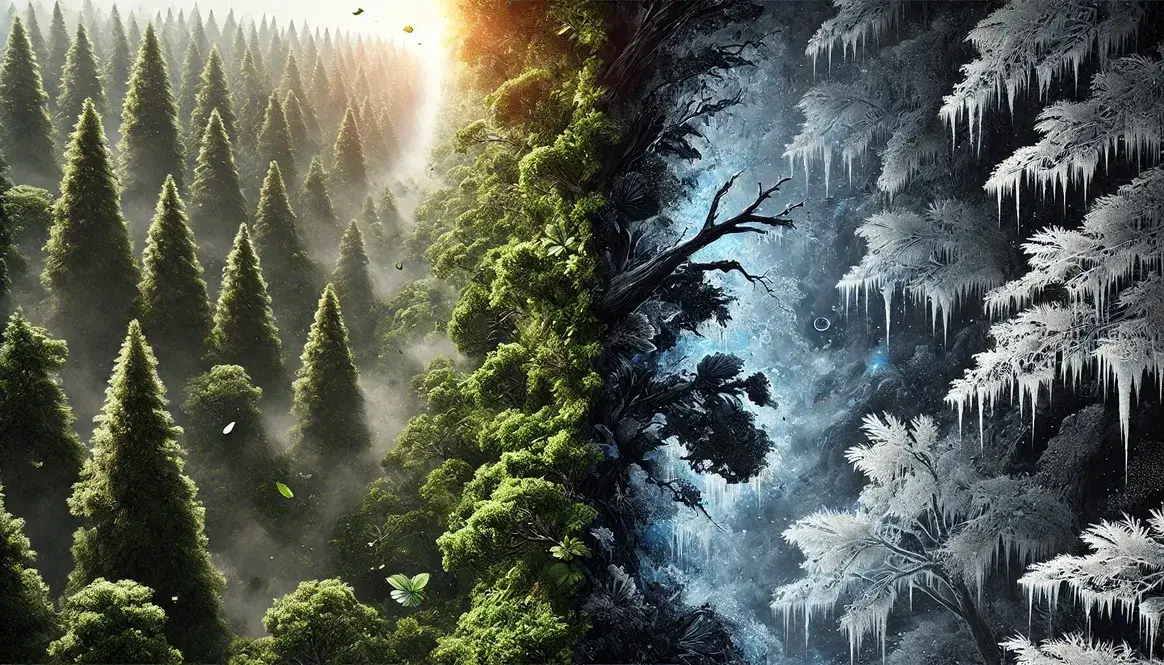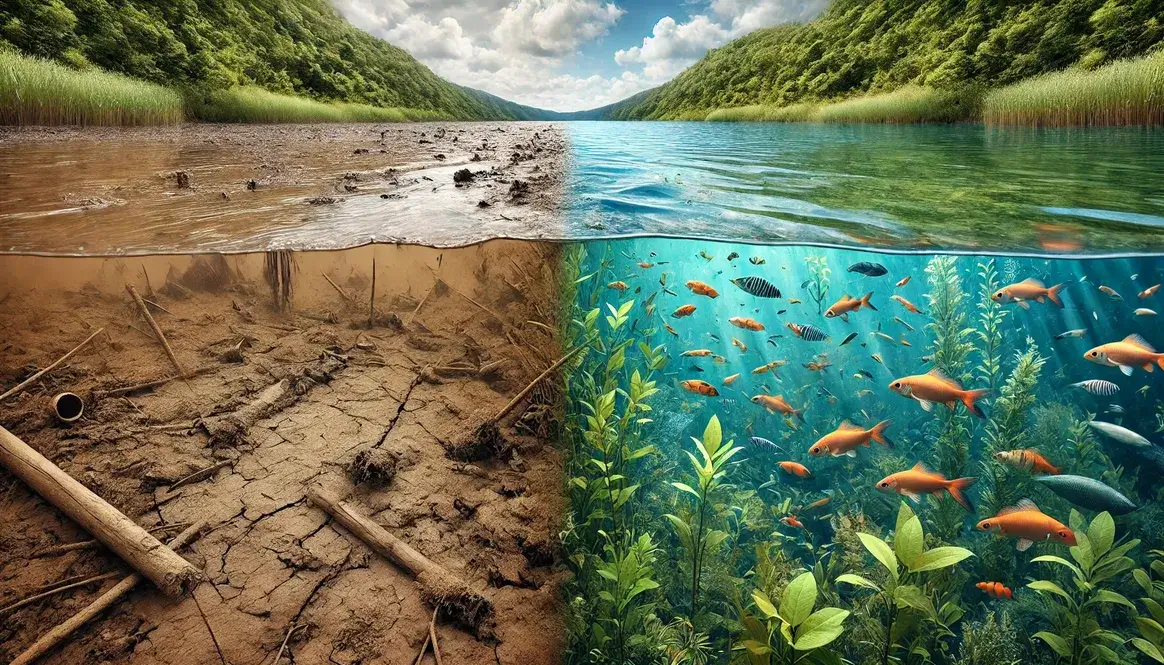If you could travel back in time to the Cretaceous period, you’d need to pack your sunscreen and light clothing. The Cretaceous, which lasted from about 145 to 66 million years ago, was one of the warmest periods in Earth’s history. So, to answer the question directly: Yes, the Cretaceous period was indeed hot.
During this time, the world was very different from what we know today. Dinosaurs roamed the land, strange creatures swam in the seas, and the first flowering plants were just beginning to appear. But one of the most striking differences was the climate. The Cretaceous was like a global greenhouse, with temperatures much higher than we experience now.
| Key Takeaways | Cretaceous Climate |
|---|---|
| Average Temperature | 10-15°C warmer than today |
| Hottest Period | Mid-Cretaceous (100-90 million years ago) |
| CO2 Levels | 4-6 times higher than present |
| Polar Regions | Frost-free, with forests and diverse animal life |
| Sea Levels | Up to 200 meters higher than today |
Just How Hot Was the Cretaceous Period?
When we talk about how hot the Cretaceous was, we’re not just talking about a few degrees warmer than today. The difference was dramatic. On average, global temperatures during the Cretaceous were about 10 to 15°C (18 to 27°F) higher than they are now. That’s a huge difference!
To put this in perspective, let’s compare it to our current climate:
| Time Period | Average Global Temperature |
|---|---|
| Present Day | About 15°C (59°F) |
| Cretaceous | About 25-30°C (77-86°F) |
These numbers might not seem that high if you live in a warm place, but remember, this was the average temperature for the entire planet. That means even the coldest parts of Earth were much warmer than they are today.
The Cretaceous wasn’t uniformly hot throughout its entire span. It had warmer and slightly cooler periods. The hottest part was during the mid-Cretaceous, about 100 to 90 million years ago. This time is often called the “Cretaceous Hothouse” or “Cretaceous Thermal Maximum.” During this peak warmth, temperatures may have been even higher than the averages we mentioned.
Interestingly, this warm climate had a big impact on sea levels. With so much heat, there were no ice caps at the poles. All that water that’s now frozen in places like Antarctica was liquid, causing sea levels to be much higher. In fact, during the Cretaceous Period, sea levels were up to 200 meters higher than they are today. That’s taller than the Eiffel Tower!
This intense heat and high sea levels created a very different world, affecting everything from the types of plants that could grow to where animals could live. It’s a fascinating example of how Earth’s climate can change over time, and it helps us understand the incredible adaptability of life on our planet.
Cretaceous Temperature Ranges
The Cretaceous period wasn’t uniformly hot throughout its entire 79-million-year span. Different parts of the Cretaceous experienced varying temperature ranges. Let’s break it down:
| Cretaceous Period | Time Range (mya) | Average Global Temperature | Notable Features |
|---|---|---|---|
| Early Cretaceous | 145-100 | 20-25°C (68-77°F) | Slightly cooler than later periods |
| Mid-Cretaceous | 100-90 | 25-30°C (77-86°F) | Peak warmth period; Some areas reaching 35-40°C (95-104°F) |
| Late Cretaceous | 90-66 | 22-27°C (72-81°F) | Gradual cooling trend |
But how do scientists figure out temperatures from millions of years ago? It’s like being a climate detective! They use several clever methods:
- Oxygen Isotope Analysis: By studying the ratio of different oxygen isotopes in fossilized shells and teeth, scientists can estimate past ocean temperatures.
- Plant Fossil Studies: The types of plants that grew in an area can indicate temperature ranges. For example, palm trees found in polar regions suggest those areas were much warmer.
- Sediment Analysis: Certain types of sediments form only under specific temperature conditions, providing clues about past climates.
- Computer Modeling: Scientists use advanced climate simulations to recreate Cretaceous conditions based on known data.
These methods help paint a picture of the Cretaceous climate, showing us just how different it was from today’s world.
Comparing Cretaceous Heat to Other Time Periods
To truly appreciate how hot the Cretaceous was, let’s compare it to other periods in Earth’s history:
| Time Period | Average Global Temperature | Comparison to Today |
|---|---|---|
| Present Day | 15°C (59°F) | Baseline |
| Cretaceous | 25-30°C (77-86°F) | 10-15°C warmer |
| Jurassic | 20-25°C (68-77°F) | 5-10°C warmer |
| Triassic | 17-22°C (63-72°F) | 2-7°C warmer |
The Cretaceous stands out as significantly warmer than its predecessors, the Jurassic and Triassic periods. While these earlier periods were also warmer than today, the Cretaceous took it to another level.
But how does the Cretaceous stack up against other known “hot” periods in Earth’s history?
- Paleocene-Eocene Thermal Maximum (PETM): This event, occurring about 56 million years ago, saw temperatures spike rapidly, reaching levels similar to the Cretaceous. However, it lasted only about 200,000 years, whereas the Cretaceous warmth persisted for millions of years.
- Carboniferous Period: This period, about 360-300 million years ago, had similar average temperatures to the Cretaceous but with more extreme seasonal variations.
- Eocene Epoch: Following the PETM, this epoch (56-33.9 million years ago) maintained high temperatures, though not quite as extreme as the Cretaceous peak.
The Cretaceous stands out not just for its high temperatures, but for the duration of its warmth. This long-term heat had profound effects on life, shaping the evolution of many species, including dinosaurs. Some dinosaurs even adapted to live in Arctic regions, which, while cooler than other parts of the world, were still much warmer than today’s Arctic.
Understanding these ancient warm periods helps scientists better comprehend how Earth’s climate can change over time and what impacts those changes can have on life.
Why Was the Cretaceous Period So Warm?
The Cretaceous period’s intense warmth wasn’t just a coincidence. Several factors worked together to create this greenhouse world. Let’s explore the main reasons behind the Cretaceous heat wave.
High Levels of Greenhouse Gases
One of the primary culprits for the Cretaceous warmth was the high concentration of greenhouse gases in the atmosphere, particularly carbon dioxide (CO2). These gases act like a blanket, trapping heat and warming the planet.
Carbon dioxide levels skyrocketed during the Cretaceous, reaching levels 4 to 6 times higher than what we have today. But where did all this CO2 come from?
- Volcanic activity: Massive volcanic eruptions released large amounts of CO2 into the atmosphere.
- Seafloor spreading: Increased tectonic activity led to more CO2 being released from the Earth’s interior.
- Methane release: Warmer oceans might have released methane trapped in seafloor sediments, adding to the greenhouse effect.
These high greenhouse gas levels created a feedback loop: as the planet warmed, it released more greenhouse gases, which caused even more warming.
Continental Positions and Ocean Currents
The arrangement of continents during the Cretaceous played a crucial role in shaping the global climate. Unlike today, the continents were positioned differently:
- Most landmasses were clustered around the equator
- There was no land mass over either pole
- The Atlantic Ocean was narrower, while the Pacific was wider
This configuration had significant impacts on climate:
- With no land at the poles, there were no large ice sheets to reflect sunlight back into space.
- The clustering of continents near the equator meant more land was exposed to intense tropical sunlight.
- Ocean currents flowed differently, distributing heat around the planet in unique ways.
The movement of ocean waters during this time was particularly important. Warm currents could reach higher latitudes more easily, spreading heat to areas that are cold today. This circulation pattern helped maintain high temperatures even in polar regions.
Increased Volcanic Activity
Volcanoes played a starring role in the Cretaceous climate drama. This period saw an uptick in volcanic activity, with some truly massive eruptions.
Key volcanic events:
- Formation of large igneous provinces, like the Deccan Traps in India
- Increased activity along mid-ocean ridges
- Subduction zone volcanism around the Pacific Ring of Fire
These volcanoes pumped out enormous quantities of CO2 and other gases, contributing to the greenhouse effect. But that’s not all – they also released ash and aerosols into the atmosphere.
While you might think ash would cool things down by blocking sunlight, the long-term effect of all this volcanic activity was warming. The greenhouse gases released by volcanoes stayed in the atmosphere much longer than the cooling ash, leading to a net warming effect over time.
All these factors – greenhouse gases, continental positions, ocean currents, and volcanoes – worked together to create the Cretaceous hothouse. Understanding these ancient climate dynamics helps scientists better grasp how Earth’s climate system works and how it might change in the future.
Regional Variations in Cretaceous Temperatures
While the Cretaceous period was generally hot, it’s important to understand that not all areas of the Earth experienced the same level of warmth. Just like today, there were regional differences in temperature, creating a diverse array of climates across the globe.
Tropical and Equatorial Regions
The tropical and equatorial regions during the Cretaceous were incredibly hot, even by the standards of the time. These areas experienced extreme heat that would be challenging for most modern life forms.
Temperature extremes:
- Average temperatures: 35-40°C (95-104°F)
- Some areas potentially reaching up to 45°C (113°F) during hot seasons
Despite these scorching temperatures, life thrived in these regions. Plants and animals developed fascinating adaptations to cope with the heat:
- Plants: Many plants evolved thick, waxy leaves to prevent water loss. Some developed deep root systems to access underground water sources.
- Dinosaurs: Some dinosaur species in hot regions may have had:
- Enhanced cooling systems, like large sail-like structures for heat dissipation
- Behavioral adaptations, such as being more active during cooler parts of the day
- Insects: Insects in these regions often grew larger due to the abundance of oxygen and food resources.
The extreme heat in these areas led to unique ecosystems that we can only imagine today. Lush rainforests and diverse animal life created a world very different from our modern tropics.
Polar Regions During the Cretaceous
One of the most surprising aspects of the Cretaceous climate was the warmth of the polar regions. Unlike the icy landscapes we see today, the Cretaceous poles were surprisingly hospitable environments.
Dinosaurs lived in Arctic and Antarctic regions, which had climates more like today’s temperate forests. Here’s what we know about these polar environments:
- Temperatures: Average annual temperatures in polar regions ranged from 10-15°C (50-59°F)
- No permanent ice: There’s no evidence of permanent ice caps during this time
- Seasonal variations: While warmer than today, these regions still experienced seasons, including periods of darkness
The evidence for warm polar regions comes from several sources:
- Fossil plants: Remains of forests, including trees similar to modern cypress and pine, have been found in polar sediments from the Cretaceous.
- Animal fossils: Dinosaur fossils, including those of plant-eaters, have been discovered in both Arctic and Antarctic regions.
- Sediment analysis: The types of sediments found in polar regions indicate warm, ice-free conditions.
These warm poles had a profound impact on global climate patterns. Without large ice sheets to reflect sunlight, the poles absorbed more heat, contributing to the overall warmth of the planet.
The diversity of life in these polar regions is particularly fascinating. Forests teeming with dinosaurs, mammals, and birds existed in areas that are now covered in ice year-round. This stark contrast helps us appreciate the dramatic climate changes our planet has undergone over millions of years.
Understanding these regional variations in Cretaceous climate not only helps us paint a more accurate picture of this ancient world but also provides valuable insights into how Earth’s climate system can operate under different conditions.
Effects of Cretaceous Heat on Life
The Cretaceous heat wave didn’t just change the planet’s temperature; it reshaped the entire biosphere. Plants and animals had to adapt quickly to survive in this greenhouse world, leading to some fascinating evolutionary changes.
For plants, the warm and CO2-rich atmosphere was like a giant greenhouse. This led to:
- Rapid growth and diversification
- The emergence of flowering plants (angiosperms)
- Expansion of forests into polar regions
But it wasn’t all rosy. Some plants had to develop special adaptations to cope with the heat and occasional droughts. To learn more about these remarkable adaptations, check out our article on how Cretaceous plants adapted to their changing environment.
For animals, the effects were equally profound:
- Dinosaurs: Many species grew to enormous sizes, taking advantage of the abundant plant life. Some developed cooling mechanisms like heat-dissipating sails or nasal passages.
- Marine life: Warm oceans led to an explosion of marine biodiversity, including the evolution of new predators like mosasaurs.
- Early mammals: Our tiny ancestors thrived in this warm world, diversifying and evolving new traits that would later prove crucial.
The Cretaceous heat also influenced animal behavior. Some species may have migrated to cooler areas during the hottest parts of the year, while others became more nocturnal to avoid the intense daytime heat.
Studying Cretaceous Climate: Challenges and Methods
Unraveling the mysteries of a climate that existed millions of years ago is no easy task. Scientists use a variety of clever techniques to piece together the Cretaceous climate puzzle:
- Fossil Analysis:
- Plant fossils provide clues about rainfall and temperature
- Animal fossils can indicate climate through their adaptations
- Sediment Studies:
- Different types of sediments form under specific climate conditions
- Layer patterns can reveal seasonal changes
- Isotope Analysis:
- Oxygen isotopes in fossilized shells indicate ocean temperatures
- Carbon isotopes can reveal information about atmospheric CO2 levels
- Biomarkers:
- Chemical traces left by ancient organisms can provide climate information
- Computer Modeling:
- Advanced simulations help recreate ancient climate conditions
These methods each have their challenges. Fossils can be incomplete, sediments can be disturbed, and isotope ratios can be altered over time. That’s why scientists often use multiple methods to cross-verify their findings.
One of the most exciting recent developments in studying ancient climates is the use of advanced computer simulations. These models can take all the available data and create a comprehensive picture of what the Cretaceous world might have looked like. For a deeper dive into this fascinating technology, check out our article on Cretaceous weather simulations.
By combining all these methods, scientists continue to refine our understanding of the Cretaceous climate, painting an ever clearer picture of this ancient greenhouse world.









